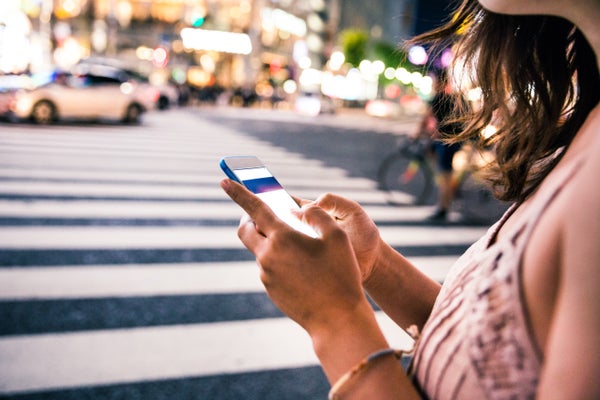This article was published in Scientific American’s former blog network and reflects the views of the author, not necessarily those of Scientific American
Texting—or checking social media or reading/responding to email or reading the news or checking the weather or watching a video—while walking is a pretty ubiquitous phenomenon. It's so common that it might no longer be the annoyance it once was. Who's left to find it a nuisance? We've all been captivated by the notification icons on our phones, so virtually no one is paying attention to where they're going.
Our mobile devices are heavily integrated in our lives. In my case, it's one of the first things I reach for in the morning, and when I get out of the car my phone is often in my hand as I walk through the parking lot to the store I'm visiting. I do try to put it away while I walk to the office from the train station though. I'm very aware that the distraction may make me a target--or put me in front of a moving vehicle. Plus, I've just been reading emails on the entire train ride in. The ten minute walk to my building is a welcome break. Usually.
Another reason we may not be complaining about texting walkers is that they're less awkward. Why don't they fall down or walk into other people? Research suggests that these texters adopt protective measures to minimize the risk of accidents when walking. They're less likely to trip because they shorten their step length, reduce step frequency, lengthen the time during which both feet are in contact with the ground, and increase obstacle clearance height. Taken together this creates an exaggerated image of walking, but it apparently slows the walker enough so that he registers some of what is happening around him and can compensate for it.
On supporting science journalism
If you're enjoying this article, consider supporting our award-winning journalism by subscribing. By purchasing a subscription you are helping to ensure the future of impactful stories about the discoveries and ideas shaping our world today.
The impact of texting and walking is that it slows the walker down. So we're all connected but it may take us longer to get to each other--which may be okay since we've likely texted the person that we're on our way and then given a play-by-play of our progress as we update social media along the way.
The study suggests that this outcome may be partially due to familiarity. The participants were between the ages of 18-50 years old and had owned a mobile phone for at least a month. According to data from Pew Internet, 90% of American adults own a cell phone, and two-thirds of American adults own a smart phone. Between the age group and the ownership requirement for this study, the people surveyed very likely fell into these categories.
We may be driving technology to respond to our needs in various areas, but this is one instance where we've definitely demonstrated that we're also adapting to accommodate technological change.
--
Referenced:
Licence S, Smith R, McGuigan MP, Earnest CP (2015) Gait Pattern Alterations during Walking, Texting and Walking and Texting during Cognitively Distractive Tasks while Negotiating Common Pedestrian Obstacles. PLoS ONE 10(7): e0133281. doi:10.1371/journal.pone.0133281
--
You might also like:
The Culture of Coffee Drinkers
How Our Love Affair with Reality Television Created Megalodon
